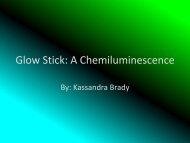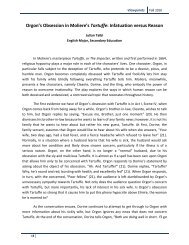Concentration Terms and Calculations - Quantum
Concentration Terms and Calculations - Quantum
Concentration Terms and Calculations - Quantum
Create successful ePaper yourself
Turn your PDF publications into a flip-book with our unique Google optimized e-Paper software.
In the case of environmental pollution, much smaller concentration terms are needed. Two ofthe most common ones are parts per million (ppm) <strong>and</strong> parts per billion (ppb). Both terms express theamount of solute per million or billion parts of solution. The solute units <strong>and</strong> solvent units must beidentical when doing the calculation.If the solvent is water <strong>and</strong> parts are grams, ppm may be redefined in mass/volume units by using 1.00g/mL for the density of a dilute aqueous solution.Similarly, ppb becomes µg solute/L solution by substituting 10 9 for 10 6 <strong>and</strong> 10 6 µg for 1000 mg in theabove equation.How to calculate the molarity of a solution from m/v%The normal level of glucose in the blood usually averages 100. mg/100. mL. Calculate the averagemolarity of glucose in blood.Solution:Write down the given values with theirunits <strong>and</strong> what they represent.In this problem, mg/v% is given for the solute glucose <strong>and</strong>the solvent blood. The chemical formula for glucose isC 6 H 12 O 6 . The molar masses of C, H, <strong>and</strong> O can be obtainedfrom the Periodic Table.mg/v% = 100. mg glucose/100. mL blood1 mol C = 12.01 g/mol1 mol O = 16.00 g/mol1 mol H – 1.008 g/molmolar mass glucose = 180.16 g/mol








